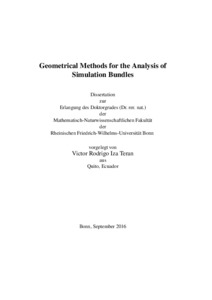Geometrical Methods for the Analysis of Simulation Bundles

Geometrical Methods for the Analysis of Simulation Bundles

| dc.contributor.advisor | Garcke, Jochen | |
| dc.contributor.author | Iza Teran, Victor Rodrigo | |
| dc.date.accessioned | 2020-04-23T20:08:01Z | |
| dc.date.available | 2020-04-23T20:08:01Z | |
| dc.date.issued | 29.03.2017 | |
| dc.identifier.uri | https://hdl.handle.net/20.500.11811/7134 | |
| dc.description.abstract | Efficiently analyzing large amounts of high dimensional data derived from the simulation of industrial products is a challenge that is confronted in this thesis. For this purpose, simulations are considered as abstract objects and assumed to be living in lower dimensional space. The aim of this thesis is to characterize and analyze these simulations, this is done by examining two different approaches. Firstly, from the perspective of manifold learning using diffusion maps and demonstrating its application and merits; the inherent assumption of manifold learning is that high dimensional data can be considered to be located on a low dimensional abstract manifold. Unfortunately, this can not be verified in practical applications as it would require the existence of several thousand datasets, where in reality only a few hundred are available due to computational costs. To overcome these restrictions, a new way of characterizing the set of simulations is proposed where it is assumed that transformations send simulations to other simulations. Under this assumption, the theoretical framework of shape spaces can be applied wherein a quotient space of a pre-shape space (the space of simulations shapes) modulo a transformation group is used. It is propound to add into this setting, the construction of positive definite operators that are assumed invariant to specific transformations. They are built using only one simulation and as a consequence all other simulations can be projected to the eigen-basis of these operators. A new representation of all simulations is thus obtained based on the projection coefficients in a very much analogous way to the use of the Fourier transformation. The new representation is shown to be significantly reduced, depending on the smoothness of the data. Several industrial applications for time dependent datasets from engineering simulations are provided to demonstrate the usefulness of the method and put forward several research directions and possible new applications. | |
| dc.language.iso | eng | |
| dc.rights | In Copyright | |
| dc.rights.uri | http://rightsstatements.org/vocab/InC/1.0/ | |
| dc.subject.ddc | 510 Mathematik | |
| dc.title | Geometrical Methods for the Analysis of Simulation Bundles | |
| dc.type | Dissertation oder Habilitation | |
| dc.publisher.name | Universitäts- und Landesbibliothek Bonn | |
| dc.publisher.location | Bonn | |
| dc.rights.accessRights | openAccess | |
| dc.identifier.urn | https://nbn-resolving.org/urn:nbn:de:hbz:5n-46487 | |
| ulbbn.pubtype | Erstveröffentlichung | |
| ulbbnediss.affiliation.name | Rheinische Friedrich-Wilhelms-Universität Bonn | |
| ulbbnediss.affiliation.location | Bonn | |
| ulbbnediss.thesis.level | Dissertation | |
| ulbbnediss.dissID | 4648 | |
| ulbbnediss.date.accepted | 20.01.2017 | |
| ulbbnediss.institute | Mathematisch-Naturwissenschaftliche Fakultät : Fachgruppe Mathematik / Institut für Numerische Simulation (INS) | |
| ulbbnediss.fakultaet | Mathematisch-Naturwissenschaftliche Fakultät | |
| dc.contributor.coReferee | Rumpf, Martin |
Files in this item
This item appears in the following Collection(s)
-
E-Dissertationen (4118)




